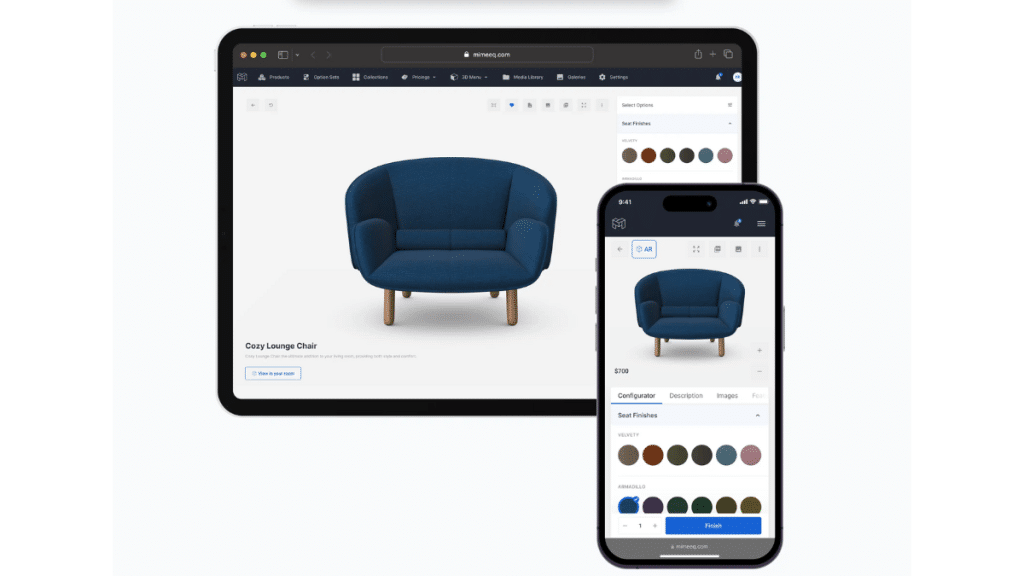Introduction
The luxury furniture market boomed to USD 25.46 billion in 2024, driven by affluent consumers seeking personalized furnishings, evolving interior design trends, and immersive 3D technology. Amid this growth, 3D product configurators have emerged as game-changers, offering real-time visualization and customization in 3D views. This helps reduce high-end purchase hesitation, boosts customer experiences, and increases sales.
This article explores how 3D configurators are transforming luxury furniture brands. Also, we highlight the key features to look for when selecting a product configurator, ensuring it can meet your brand demands, functional requirements, and customer expectations.
What are 3D product configurators?
A 3D product configurator is a digital tool powered by 3D technology that allows users to build, design, customize, and interact with designs in 360 degrees It provides real-time visualizations, ensuring that buyers can see precisely how their selected options and combinations, like materials, finishes, and dimensions, will look on the finalized products.
With highly modular products like furniture, these product configurators offer even greater value by enabling rule-based configuration. This means that only compatible combinations are allowed, effectively reducing errors and streamlining the sales process. In the luxury industry, where quality expectations are high and mistakes can be costly, the high level of precision is key to encouraging customer loyalty and brand reputation.
The top 3d configurator platforms for furniture on the market are VividWorks, Threekit, Cylindo, and more.
Why do luxury furniture brands need 3D configurators?
#1. Deliver high-end bespoke personalization
3D configurators can empower customers to create one-of-a-kind pieces tailored to their preferences without sales teams. Shoppers can freely experiment with different materials until the design perfectly matches their vision, and all changes are updated in real-time. This satisfies the growing demand for exclusivity and reduces the risk of dissatisfaction and product returns, as customers know exactly what they are getting before they buy.
#2. Increase sales and save efforts for luxury furniture brands
Interactive 3D views enable customers to visualize furniture from every angle, eliminating uncertainty and making them more confident. Once they feel more trusting about their selection, they’re more likely to commit, including paying high prices for luxury products. As a result, luxury furniture brands can close deals faster and increase conversion rates.
On the other hand, many smart eCommerce teams are adopting 3D configurators to optimize performance. These configurators reduce manual work, shorten sales cycles, and eliminate costly back-and-forths in the customization process and communications. This results in significant time and cost savings for sales, design, and production teams.
#3. Reinforce brand prestige through innovation
Becoming a pioneer in your niche comes with advantages, and that’s why leveraging cutting-edge 3D tools like 3D product configurators is essential, especially for startups. Competing against well-established names is no easy feat, but this innovation can help.
These product configurators not only modernize the shopping experience but also communicate that your brand is progressive, design-driven, and customer-focused. Consequently, you can engage customers, establish your brand identity, and drive sales.
#4. Level up customer experience with 3D room planning
Some advanced 3D product configurators go beyond product configuration and customization by offering integrated 3D room planners. These tools allow customers to design and personalize entire spaces, closely mimicking their real-life environments. Everyone only places their own designs into a virtual version of their living room or office; they can evaluate exactly how each piece fits in scale, layout, color harmony, and more.
Key features to look for in 3D furniture configurators
To ensure the best sales performance and captivate luxury furniture buyers effectively, your 3D product configurator should feature some of the essential functions, including:
1. Real-time, 3D customization
Undoubtedly, 3D configurators ensure precise, instant 3D visualizations every time customers tweak the product features, such as materials, sizes, colors, and dimensions. This provides an engaging, fluid experience, allowing buyers to explore endless combinations confidently and close deals faster, thanks to increased satisfaction.
2. Visual CPQ
Visual Configure, Price, and Quote (Visual CPQ) allows for configuring luxury furniture and simultaneously seeing its prices and quotes. This fosters trust among affluent customers who value clarity, especially when shopping for high-cost products like luxury furniture. Brands can then streamline decision-making and boost the shopping experience.
3. Rule-based configuration
The rule-based configuration is always highlighted in highly modular or complex items, especially in the luxury furniture industry, where the margin for error should be minimal. This feature of the 3D product configurators ensures feasible finalized product designs, protecting the luxury furniture brand and the customer from disappointment or rework.
4. Seamless integration
Not only does seamless eCommerce integration exist, but most product configurators can also work well with ERPs and CRMs to create a unified, centralized inner workflow. This is especially critical for luxury retailers, as it ensures accurate database across channels, streamlines order processing, and supports an efficient and scalable operation.
5. Augmented Reality (AR)
AR enables the creation of more compelling and immersive luxury furniture designs. Customers can visualize their personalized products in their own space on websites or using their mobile devices, helping them assess scale and fit in a real-world environment. In other words, this bridges the gap between digital customization & physical ownership.
Conclusion
Hopefully, you can clarify everything about 3D product configurators and their roles in encouraging the growth of the luxury furniture industry and furniture brand revenues. Remember to invest in a well-structured product configurator that offers the key features and effectively satisfies the personalized demands of configuring, pricing, and quoting.
Visit Metapress Technology to learn more insights about technological innovations.
